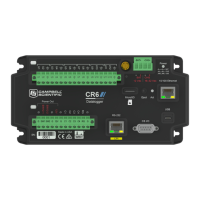Control decisions can be based on time, an event, or a measured condition. Controlled devices
can be physically connected to C, U, or SW12 terminals. Short Cut has provisions for simple
on/off control. Control modules and relay drivers are available to expand and augment data
logger control capacity.
l C and U terminals are selectable as binary inputs, control outputs, or communication ports.
These terminals can be set low (0 VDC) or high (3.3 or 5 VDC) using the PortSet() or
WriteIO() instructions. See the CRBasic Editor help for detailed instruction information
and program examples: https://help.campbellsci.com/crbasic/cr6/. Other functions include
device-driven interrupts, asynchronous communications and SDI-12 communications. The
high voltage for these terminals defaults to 5 V, but it can be changed to 3.3 V using the
PortPairConfig() instruction. A C or U terminal configured for digital I/O is normally
used to operate an external relay-driver circuit because the terminal itself has limited drive
capacity.
l SW12 terminals can be set low (0 V) or high (12 V) using the SW12() instruction (see the
CRBasic help for more information).
The following image illustrates a simple application wherein a C or Uterminal configured for
digital input, and another configured for control output are used to control a device (turn it on
or off) and monitor the state of the device (whether the device is on or off).
2. Wiring panel and terminal functions 17

